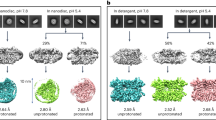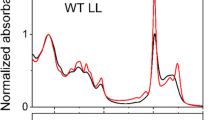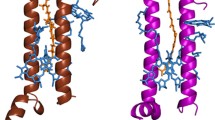Abstract
The P3 mutant of Rhodobacter sphaeroides had an altered ratio of reaction center to core (LH1) and peripheral (LH2) antenna complexes compared to the wild-type strain. Intracytoplasmic membranes from these two strains were purified and then resuspended in buffer or immobilized in isotropic and stretched polymer film. The absorption, photoacoustic, and delayed luminescence spectra were measured. The ratios of infrared absorption and photoacoustic bands (located at about 880 nm for LH1 and at 850 and about 800 nm for LH2) as well as the half-width of these bands are different for the LH2 and LH1 mutants and wild-type strain. The whole yields of thermal deactivation of the two strains were comparable, but in the absorption region of LH2 it was slightly lower in the case of the mutant than for the wild-type strain. The delayed luminescence main maxima were observed at about 860 and 700 nm. The first one could be due to emission of bacteriochlorophyll a of LH2 complexes. The emission at about 700 nm is probably due to dihydromesochlorophyll, which is usually, to some extent, produced from bacteriochlorophyll a in bacterial complexes. The delayed luminescence emission is competing with excitation energy transfer to the reaction center. The intensity of the delayed luminescence of the mutant strain was higher than that of the wild-type strain when both samples were excited in a region of carotenoid absorption. The mutant contains less carotenoids than the wild-type strain. Carotenoids work as efficient antenna. When they at a lower concentration the excitation can be trapped more easily by some chlorophyll-like pigment isolated from the excitation energy chain. The dependences of delayed luminescence spectra on the light polarization and excitation wavelengths for the wild-type strain and for the mutant were different. The anisotropy of delayed luminescence showed that bacteriochlorophyll a molecules of different orientations were contributing to the mutant and the wild-type strain emission. All the results suggest that the excitation energy transfer from the antenna to the reaction center in the mutant and the wild-type strain is similar.
Similar content being viewed by others
REFERENCES
C. Francke and J. Amesz (1995) Photosynth. Res. 46, 347–352.
P. McGlynn, W. H. J. Westerhuis, M. R. Jones, and C. N. Hunter (1996) J. Biol. Chem. 271, 3885–3892.
J. Aagaard and W. R. Sistrom (1972) Photochem. Photobiol. 15, 209–225.
T. G. Monger and W. W. Parson (1977) Biochim. Biophys. Acta 460, 393–407.
L. Vasilyeva, M. Hara, M. Miyake, E. Nakada, Y. Asada, and J. Miyake (1997) in Book of Abstracts for IX International Symposium on Phototropic Prokaryotes, Sept. 6–13, Vienna, Austria, p. 106.
L. Vasilieva, M. Miyake, E. Nakada, Y. Asada, and J. Miyake (1999) in O. R. Zaborski et al. (Eds.), BioHydrogen, Plenum Press, New York.
S. Hess, K. Visschler, J. Ulander, T. Pulleris, M. R. Jones, C. N. Nunter, and V. Sunström (1993) Biochemistry 32, 10314–10322.
H. Kramer, M. R. Jones, G. J. S. Fowler, C. Francke, T. J. Aartsma, C. N. Hunter, and J. Amesz (1995) Biochim. Biophys. Acta 1231, 89–97.
S. W. Mainhardt, P. J. Kiley, S. Kaplan, A. R. Crofts, and S. Harayama (1985) Arch. Biochem. Biophys. 236, 130–139.
L. Vasilyeva M. Miyake, M. Hara, E. Nakada, S. Nishikata, Y. Asada, and J. Miyake (1998) in O. R. Zaborsky et al. (Eds.), BioHydrogen, Plenum Press, New York.
T. Martyński, D. Fr{ie355-1}ckowiak, J. Miyake, A. Dudkowiak, and A. Piechowiak (1998) J. Photochem. Photobiol. B Biol. 42, 57–66.
J. R. Lakowicz (1983) Principles of Fluorescence Spectroscopy, Plenum Press, New York.
M. M. Bradford (1976) Anal. Biochem. 72, 248–254.
P. A. Loach and P. S. Parkes-Loach (1995) in R. E. Blankenship et al. (Eds.), Anoxygenic Photosynthetic Bacteria, Kluwer Scientific, Dordrecht, The Netherlands, pp. 437–471.
D. Fr{ie355-2}ckowiak, S. Hotchandani, and R. M. Leblanc (1985) Photochem. Photobiol. 42, 559–565.
K. Fiksiński and D. Fr{ie355-3}ckowiak (1980) Spectrosc. Lett. 13, 873–889.
G. Mc Dermott, S. M. Prince, A. A. Freer, A. M. Hafthornthwaite-Lawless, M. Z. Papiz, R. J. Cogdell, and N. W. Isaacs (1995) Nature 374, 517–521.
B. Norden (1978) Appl. Spectrosc. Rev. 14, 157–248.
D. Ducharme, A. Tessier, and R. M. Leblanc (1979) Rev. Sci. Instrum. 50, 1461–1462.
A. Planner and D. Fr{ie355-4}ckowiak (1991) Photochem. Photobiol. 54, 445–451.
D. Fr{ie355-5}ckowiak, A. Dudkowiak, B. Zelent, and R. M. Leblanc (1991) J. Fluoresc. 1, 225–234.
D. Fr{ie355-6}ckowiak, I. Gruda, M. Niedbalska, M. Romanowski, and A. Dudkowiak (1990) J. Photochem. Photobiol. A Chem. 54, 37–48.
R. van Grondelle, J. P. Dekker, T. Grillbro, and V. Sundstrom (1994) Biochim. Biophys. Acta 1187, 1–65.
D. Fr{ie355-7}ckowiak, A. Dudkowiak, R. Cegielski, A. Planner, and C. Schulz (1995) Photosynthetica 31, 283–299.
A. Rosencwaig (1980) Photoacoustics and Photoacoustics Spectroscopy, J. Wiley Interscience, New York.
H. Van Amerongen, S. L. S. Kwa, B. M. van Bolhuis, and R. van Grondelle (1994) Biophys. J. 67, 837–847.
J. Deisenhoffer, O. Epp, K. Miki, R. Huber, and H. Michel (1985) Nature 318, 618–624.
S. Karrasch, P. A. Bullough, and R. Ghosh (1995) EMBO J. 14, 631–638.
S. Karrash, P. A. Bullough, and R. Gosh (1995) in P. Mathis (Ed.), Photosynthesis from Light to Biosphere, Kluwer Academic Dodrecht, Boston, London, p. 81.
H. J. M. Kramer, R. van Grondelle, C. N. Hunter, and W. H. J. Westerhuis (1984) Biochim. Biophys. Acta 765, 156–165.
H. van Amerongen, B. van Haeringen, M. van Gurp, and R. van Grondelle (1991) Biophys. J. 59, 992–1001.
Author information
Authors and Affiliations
Corresponding author
Rights and permissions
About this article
Cite this article
Goc, J., Planner, A., Frackowiak, D. et al. The Paths of Excitation Energy Deactivation in LH1 Reduced Mutant and Wild-Type Strains of Rhodobacter sphaeroides . Journal of Fluorescence 9, 347–355 (1999). https://doi.org/10.1023/A:1020544226075
Issue Date:
DOI: https://doi.org/10.1023/A:1020544226075




